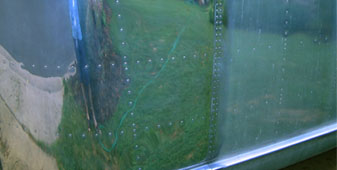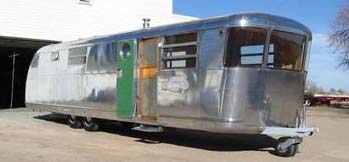|
Trailer
polishing information
|
|
| This
is a follow-up on some new techniques and observations that I have made.
It seems that there are many ways to go about getting the same result. |
1.
Acid Baths: I do not believe this is necessary.
A good wash with soap and water is what I would recommends as a starting
point.
|
2.
Compounding: Compounding is the first step to
achieving a good polish. It takes off the years of weathering. The trailer
that I am polishing has/had 55+ years of oxidation. It is very frustrating
to spend a lot of time with a product that is not course enough to rapidly
see results.
I have
tried two techniques both seem to work well.
1st:
From a tip by Brian Casson, who has done a very nice job polishing his
1950 Royal Mansion, I tried using 3M Super Duty Rubbing Compound. This
is a product that used correctly will give you instant results. My technique
was to apply small dabs of the material about
a 1/4 teaspoon in 5 inch intervals
over a two square foot area. I then compounded with a wool bonnet at
400 rpm. Compound
the surface until nothing is left, repeating the process until the surface
is free of pitting for my trailer this took 4 or 5 passes. It's
price at around $10 a quart makes it relatively inexpensive.
|
|
|
|
Brain
Casson's polished 1950 Royal Mansion
|
|
2nd:
From
the Perfect Polish people I tried using Nuvite G6. I followed the application
procedure found at www.perfectpolish.com.
The Nuvite is more expensive than the 3m Super Duty rubbing compound at
around $49 a pound but in my opinion the cost is worth it. The cut is
much more aggressive than the 3m Super Duty and about half as much needed.
I have some heavy oxidation and pitting on my trailer that I was never
fully satisfied with the outcome from past polishing procedures the G6
has been the only product to cut through and give a high shine.
|
 |
| Test area
with Nuvite G6 followed by F7. Approx time to take area from oxidation
on right to shine on left 1 hour to 5 square feet. |
|
| 3.
Removing Compounding Residue: With both the 3M compound
and the Nuvite the residue should be mostly removed by the compounding tool.
What is left can be wiped off with a soft cotton rag. No more mineral spirits!
|
| 4.
Cyclo polishing:
Once you have compounded you will be left with swirl marks which need to
be removed, this is where the Cyclo comes in. The perfect polish technique,
www.perfectpolish.com,
seems to be the most effective. I followed up the Compounding with Nuvite
F7, nothing finer, and have gotten very nice results. Using the Cyclo wraps
works very well. The one thing that I really like about this is the ease
of clean up. Once again no more mineral spirits. I have also found that
the wraps are not that hard to clean with soap and water and can be used
again and again. This is better than the mounds of black rags that were
soaked in mineral spirits and thrown away. |
| 4.
Preserving the finish:
Not a lot has been discussed on how to preserve the hard work of getting
a good shine. The best way to keep a trailer shinny is to keep it out of
the elements. No problem if you have a warehouse but I don't. My trailer
sits outside 24/7. After one rainstorm I can see a difference in the reflective
quality of the skin and streaking from water runoff. I have begun applying
wax with the Cyclo after polishing. I know that this will not give permanent
protection but hopefully it slows the dulling process down. With the Cyclo
I am able to cover a good 10 square foot area with wax in a matter of minutes.
I use the green foam pads for the application and the Cyclo wraps to remove
the wax. Its quick and easy. |
|

